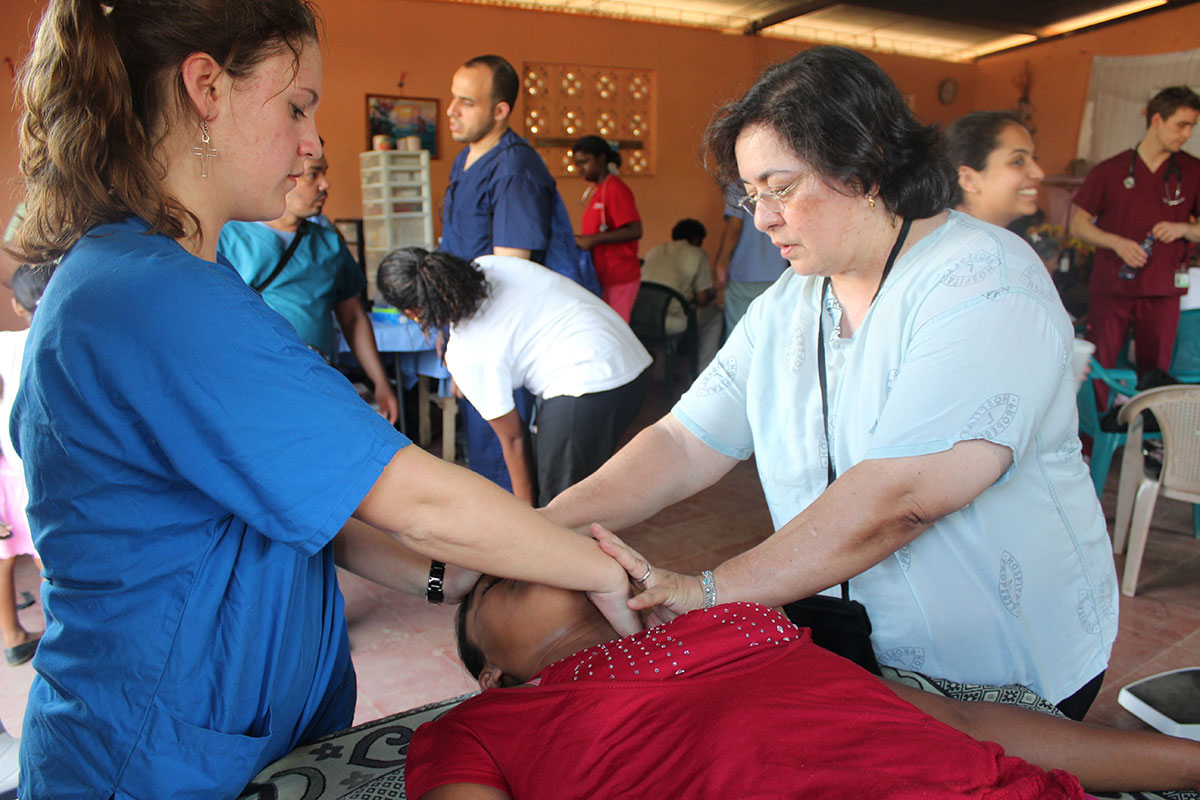TouroCOM Students Travel to Nicaragua on Medical Mission
Students Provide Treatment to More Than 300 Underserved Residents

New York, N.Y. – The patient was in so much pain from falling off a hammock that she was limping and didn’t want to move - even to flex her toes. The medical student placed her on a table, lying on her stomach, where she manipulated her legs, knees and feet to relax her muscles. Ten minutes later she got up and was walking normally.
“She didn’t need any help. She was laughing and smiling, and when we started she was crying,” recalled Nina Shah, a first-year student at Touro College of Osteopathic Medicine (TouroCOM) in Harlem. “She said, ‘They fixed me! I don’t feel anymore pain!’ After that everybody wanted to be treated with OMM (osteopathic manipulative medicine).”
The woman was one of approximately 300 patients seen during a recent medical mission to Nicaragua organized by Cindy Agu, a first-year student studying osteopathic medicine at TouroCOM. Agu had been on a similar mission, to Panama, while an undergraduate at University of California, Riverside, and was eager to go on another as soon as possible upon arriving at TouroCOM last fall.
Agu needed to pull together at least 15 students in order to make another trip with the support of Global Medical Training (GMT), a humanitarian organization that arranges missions for students who want to expand their understanding of medicine outside of North America. Agu sent an email to her fellow students and in short order registered 20 of her first-year peers and a faculty mentor, Assistant Professor Grace Vasconez-Pereira, DO.
“The purpose was to provide free medical care to rural communities in Nicaragua. We wanted to help people who can’t get medical care or go to hospitals because they live too far or can’t afford to pay for doctors,” said Agu, who was born in Nigeria. “I had been there and had seen how people suffered there and in Panama, and I wanted to take what I had learned here in the United States to underserved communities.”
With the support of GMT, which made the travel arrangements and provided accommodations, translators, and access to local physicians who assisted with diagnoses and provided medications, the group spent a week in Nicaragua – working three days at makeshift clinics they set up in schoolhouses and a church in remote areas of Granada, Managua and Masaya.
Although they were only six months into their first year of medical school, they had been trained to do physical exams and take patient histories. They brought their stethoscopes, blood pressure cuffs and ophthalmoscopes, and saw patients ranging in age from infants to the elderly. Most of the residents they saw, Agu said, suffered from gastritis, depression and parasitic infections caused by unsanitary drinking water and other living conditions – lower back pain from farming and repetitive motions was common, which the students treated with osteopathic manipulative treatments.
Lacking the treatment tables back home, improvisation was common. “We used any tables the people had over there. We were treating on the benches, on the floors, we were working everywhere,” recalled Dr. Vasconez-Pereira. “The students were so fantastic. They were well-prepared to help with the basic, common conditions like lower back and shoulder and wrist pain, using what they had learned at school.”
It took hours to get to the rural sites where they would work. Dr. Vasconez-Pereira, who assisted Shah in treating the woman who had fallen from the hammock, recalled traveling five hours by bus and another three hours by canoe up a river to the remote village where the clinic site was set up. But it was worth it, she noted. “She was so lucky we were there. Afterwards, they said, ‘We are completely grateful for you.’ They brought fruit for us.’’ After other patients waiting in line saw the woman leave the table, smiling, “suddenly everybody was having pain and wanted to be touched by the doctors,” Dr. Vasconez-Pereira said.
Both Agu and Shah noted that, in addition to the satisfaction they felt in helping those less fortunate, their work in Nicaragua advanced their skills. “We learned how to better use our techniques,” said Agu, who is planning to organize another mission – to the Dominican Republic – in December. “In school we read and practice on each other but doing an exam on a patient is different because they are actually sick and you can see the problems. Our classmates - their heart and lungs sound perfectly fine.”
Shah said, “School prepared me very well to see these patients and I felt like everything we learned was falling into place. I became more confident in my abilities. It opened my eyes to what medicine can do, to what we can do, even as students, to help people.”
TouroCOM students on the mission were Cindy Agu, Jonathon Marshall, Shaft Sirajee, Marina Kishlyansky, Paola Reveco, Nina Shah, Neel Tank, Jim Flanagan, Karen Justiniano, Gabrielle Rozenberg, Jemima Akinsanya, Bethlehem Kassaye, Erica Mirigliani, Beredu Teressa, Anita Garg, Brian Pritchard, Pavan Raju, Sheena Sharpe, Ruchi Vikas, and Ehab Yasin.

